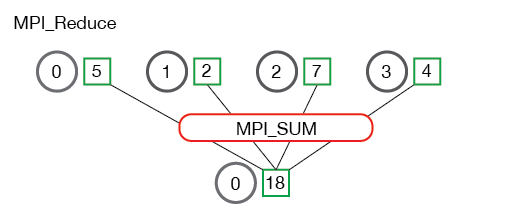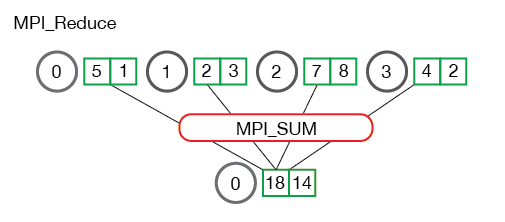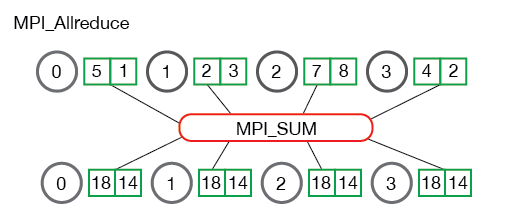MPI Reduce and Allreduce
Author: Wes Kendall在 上一节 中,我们介绍了一个使用MPI_Scatter和MPI_Gather的计算并行排名的示例。 。
在本课中,我们将通过MPI_Reduce和MPI_Allreduce进一步扩展集体通信例程。
Note - 本教程的所有代码都在 GitHub 上。本教程的代码位于 tutorials/mpi-reduce-and-allreduce/code 下。
归约简介
归约 是函数式编程中的经典概念。
数据归约包括通过函数将一组数字归约为较小的一组数字。
例如,假设我们有一个数字列表 [1,2,3,4,5]。
用 sum 函数归约此数字列表将产生 sum([1、2、3、4、5]) = 15。
类似地,乘法归约将产生 multiply([1、2、3、4、5]) = 120。
就像您想象的那样,在一组分布式数字上应用归约函数可能非常麻烦。
随之而来的是,难以有效地实现非可交换的归约,即必须以设定顺序发生的缩减。
幸运的是,MPI 有一个方便的函数,MPI_Reduce,它将处理程序员在并行程序中需要执行的几乎所有常见的归约操作。
MPI_Reduce
与 MPI_Gather 类似,MPI_Reduce 在每个进程上获取一个输入元素数组,并将输出元素数组返回给根进程。
输出元素包含减少的结果。
MPI_Reduce 的原型如下所示:
MPI_Reduce(
void* send_data,
void* recv_data,
int count,
MPI_Datatype datatype,
MPI_Op op,
int root,
MPI_Comm communicator)
send_data 参数是每个进程都希望归约的 datatype 类型元素的数组。
recv_data 仅与具有 root 秩的进程相关。
recv_data 数组包含归约的结果,大小为sizeof(datatype)* count。
op 参数是您希望应用于数据的操作。
MPI 包含一组可以使用的常见归约运算。
尽管可以定义自定义归约操作,但这超出了本教程的范围。
MPI 定义的归约操作包括:
MPI_MAX- 返回最大元素。MPI_MIN- 返回最小元素。MPI_SUM- 对元素求和。MPI_PROD- 将所有元素相乘。MPI_LAND- 对元素执行逻辑与运算。MPI_LOR- 对元素执行逻辑或运算。MPI_BAND- 对元素的各个位按位与执行。MPI_BOR- 对元素的位执行按位或运算。MPI_MAXLOC- 返回最大值和所在的进程的秩。MPI_MINLOC- 返回最小值和所在的进程的秩。
下面是 MPI_Reduce 通信模式的说明。

在上图中,每个进程包含一个整数。
调用 MPI_Reduce 的根进程为 0,并使用 MPI_SUM 作为归约运算。
这四个数字相加后将结果存储在根进程中。
查看当进程拥有多个元素时会发生什么也很有用。 下图显示了每个进程归约多个数字的情况。

上图中的每个进程都有两个元素。 结果求和基于每个元素进行。 换句话说,不是将所有数组中的所有元素累加到一个元素中,而是将每个数组中的第 i 个元素累加到进程 0 结果数组中的第 i 个元素中。
现在您了解了 MPI_Reduce 的外观,我们可以尝试一些代码示例。
使用 MPI_Reduce 计算均值
在 上一节 中,我们展示了如何使用 MPI_Scatter 和 MPI_Gather 计算平均值。
使用 MPI_Reduce 可以简化上一节的代码。
以下是本节示例代码中 reduce_avg.c 的片段。
float *rand_nums = NULL;
rand_nums = create_rand_nums(num_elements_per_proc);
// Sum the numbers locally
float local_sum = 0;
int i;
for (i = 0; i < num_elements_per_proc; i++) {
local_sum += rand_nums[i];
}
// Print the random numbers on each process
printf("Local sum for process %d - %f, avg = %f\n",
world_rank, local_sum, local_sum / num_elements_per_proc);
// Reduce all of the local sums into the global sum
float global_sum;
MPI_Reduce(&local_sum, &global_sum, 1, MPI_FLOAT, MPI_SUM, 0,
MPI_COMM_WORLD);
// Print the result
if (world_rank == 0) {
printf("Total sum = %f, avg = %f\n", global_sum,
global_sum / (world_size * num_elements_per_proc));
}
在上面的代码中,每个进程都会创建随机数并计算和保存在 local_sum 中。
然后使用 MPI_SUM 将 local_sum 归约至根进程。
然后,全局平均值为 global_sum / (world_size * num_elements_per_proc)。
如果您从 repo 的 tutorials 目录中运行 reduce_avg 程序,则输出应与此类似。
>>> cd tutorials
>>> ./run.py reduce_avg
mpirun -n 4 ./reduce_avg 100
Local sum for process 0 - 51.385098, avg = 0.513851
Local sum for process 1 - 51.842468, avg = 0.518425
Local sum for process 2 - 49.684948, avg = 0.496849
Local sum for process 3 - 47.527420, avg = 0.475274
Total sum = 200.439941, avg = 0.501100
现在是时候接触 MPI_Reduce 的同级对象 - MPI_Allreduce 了。
MPI_Allreduce
许多并行程序中,需要在所有进程而不是仅仅在根进程中访问归约的结果。
以与 MPI_Gather 相似的补充方式,MPI_Allreduce 将归约值并将结果分配给所有进程。
函数原型如下:
MPI_Allreduce(
void* send_data,
void* recv_data,
int count,
MPI_Datatype datatype,
MPI_Op op,
MPI_Comm communicator)
您可能已经注意到,MPI_Allreduce 与 MPI_Reduce 相同,不同之处在于它不需要根进程 ID(因为结果分配给所有进程)。
下图介绍了 MPI_Allreduce 的通信模式:

MPI_Allreduce 等效于先执行 MPI_Reduce,然后执行 MPI_Bcast。
很简单,对吧?
使用 MPI_Allreduce 计算标准差
许多计算问题需要进行多次归约来解决。 一个这样的问题是找到一组分布式数字的标准差。 或许您可能已经遗忘了什么是标准差,标准差是数字与均值之间的离散程度的度量。 较低的标准差表示数字靠得更近,对于较高的标准差则相反。
要找到标准差,必须首先计算所有数字的平均值。 总和均值的平方根是最终结果。 给定问题描述,我们知道所有数字至少会有两个和,转化为两个归约。 本文代码 reduce_stddev.c 中的一个片段展示了如何应用 MPI 解决此问题的概况。
rand_nums = create_rand_nums(num_elements_per_proc);
// Sum the numbers locally
float local_sum = 0;
int i;
for (i = 0; i < num_elements_per_proc; i++) {
local_sum += rand_nums[i];
}
// Reduce all of the local sums into the global sum in order to
// calculate the mean
float global_sum;
MPI_Allreduce(&local_sum, &global_sum, 1, MPI_FLOAT, MPI_SUM,
MPI_COMM_WORLD);
float mean = global_sum / (num_elements_per_proc * world_size);
// Compute the local sum of the squared differences from the mean
float local_sq_diff = 0;
for (i = 0; i < num_elements_per_proc; i++) {
local_sq_diff += (rand_nums[i] - mean) * (rand_nums[i] - mean);
}
// Reduce the global sum of the squared differences to the root
// process and print off the answer
float global_sq_diff;
MPI_Reduce(&local_sq_diff, &global_sq_diff, 1, MPI_FLOAT, MPI_SUM, 0,
MPI_COMM_WORLD);
// The standard deviation is the square root of the mean of the
// squared differences.
if (world_rank == 0) {
float stddev = sqrt(global_sq_diff /
(num_elements_per_proc * world_size));
printf("Mean - %f, Standard deviation = %f\n", mean, stddev);
}
在上面的代码中,每个进程都会计算元素的局部总和 local_sum,并使用 MPI_Allreduce 对它们求和。
在所有进程上都有全局总和后,将计算均值 mean,以便可以计算局部距平的平方 local_sq_diff。
一旦计算出所有局部距平的平方,就可以通过使用 MPI_Reduce 得到全局距平的平方 global_sq_diff。
然后,根进程可以通过取全局距平的平方的平均值的平方根来计算标准差。
使用运行脚本运行示例代码将产生如下输出:
>>> ./run.py reduce_stddev
mpirun -n 4 ./reduce_stddev 100
Mean - 0.501100, Standard deviation = 0.301126
Up next
现在您可以轻松使用所有常见的集合 - MPI_Bcast,MPI_Scatter,MPI_Gather 和 MPI_Reduce,我们可以利用它们来构建复杂的并行程序。
在下一节中,我们将开始研究 MPI 组和通讯器.
对于所有教程,请转到 MPI 教程部分.